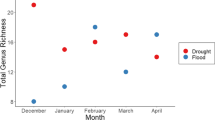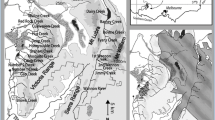Abstract
In 2005 and 2006, the United States Army Corps of Engineers released experimental flows to mimic natural spring flooding on the highly regulated lower Savannah River in the Southeastern US. We used vegetation, invertebrate, and fish communities to assess how past regulation and current experimental releases were affecting the ecological conditions on floodplains. The nearby Altamaha River, of similar size but retaining near-natural spring pulses, served as a reference. We did not find that past flow regulation of the Savannah River had significantly altered floodplain forest structure. However, numbers of tree seedlings in bottomland hardwood forests were higher during a year with an artificial pulse than one without. Analyses of invertebrate and fish communities suggested some limited differences in floodplain community structure between rivers, with differences being most pronounced for predaceous Dytiscidae beetles and Esox spp. fishes. Artificial re-creation of small spring flood pulses down the Savannah River in 2005 and 2006 elicited some responses from fish and invertebrates, but did not shift species assemblages towards those occurring on Altamaha River floodplains.





Similar content being viewed by others
References
Agostinho AA, Gomes LC, Veríssimo S, Okada EK (2004) Flood regime, dam regulation and fish in the Upper Paraná River: effects on assemblage attributes, reproduction and recruitment. Rev Fish Biol Fish 14:11–19
Benke AC (1990) A perspective on America’s vanishing streams. J North Am Benthol Soc 9:77–88
Bright EG, Batzer DP, Garnett JA (2010) Variation in invertebrate and fish communities across floodplain ecotones of the Altamaha and Savannah Rivers. Wetlands 30:1117–1128
Darst MR, Light HM (2008) Drier forest composition associated with hydrologic change in the Apalachicola River floodplain, Florida. U.S. Geological Survey Scientific Investigations Report 2008–5062
Dufrene M, Legendre P (1997) Species assemblages and indicator species: the need for a flexible asymmetrical approach. Ecol Monogr 67:345–366
Dynesius M, Nilsson C (1994) Fragmentation and flow regulation of river systems in the northern third of the world. Science 266(5186):753–762
Finger TR, Stewart EM (1987) Response of fishes to flooding regime in lowland hardwood wetlands. In: Matthews WJ, Heins DC (eds) Community and evolutionary ecology of North American stream fishes. University of Oklahoma Press, Norman
Galatowitsch ML, Batzer DP (2011) Benefits and costs of Leptophlebia (Ephemeroptera) mayfly movements between river channels and floodplain wetlands. Can J Zool 89:714–723
Garnett JA, Batzer DP (2014) Longitudinal variation in community structure of floodplain fishes along two rivers of the southeastern U.S. Can J Fish Aquat Sci 71:1291–1302
Gubiani ÉA, Gomes LC, Agostinho AA, Okada EK (2007) Persistence of fish populations in the upper Paraná River: effects of water regulation by dams. Ecol Freshw Fish 16:191–197
Hall AA, Rood SB, Higgins PS (2011) Resizing a river: a downscaled, seasonal flow regime promotes riparian restoration. Restor Ecol 19:351–359
Henke JA (2005) Assessing the efficacy of different sampling methods and determining length-mass relationships for wetland invertebrates. MS Thesis, University of Georgia, Athens
Hupp CR, Pierce AR, Noe GB (2009) Floodplain geomorphic processes and environmental impacts of human alteration along Coastal Plain rivers, USA. Wetlands 29:413–429
Johnson WC, Dixon MD, Scott ML, Rabbe L, Larson Volke GM, Werner B (2012) Forty years of vegetation change on the Missouri River floodplain. Bioscience 62:123–135
Junk WJ, Bayley PB, Sparks RE (1989) The flood pulse concept in river-floodplain systems. In: Dodge DP (ed) Proceedings of the international large river symposium. Can Spec Publ Fish Aquat Sci 106, pp 110–127
Knight JG, Bain MB (1996) Sampling fish assemblages in forested floodplain wetlands. Ecol Freshw Fish 5:76–85
Lee LS (2008) Potential effects of altered hydrology on floodplain forests of the Savannah River. MS thesis, University of Georgia, Athens
Leigh C, Stewart-Koster B, Sheldon F, Burford MA (2012) Understanding multiple ecological responses to anthropogenic disturbance: rivers and potential flow regime change. Ecol Appl 22:250–263
Marcy BC, Fletcher DE, Martin FD, Paller MH, Reichert MJM (2005) Fishes of the Middle Savannah River Basin: With Emphasis on the Savannah River Site. University of Georgia Press, Athens
Merritt DH, Cooper DJ (2000) Riparian vegetation and channel change in response to river regulation: a comparative study of regulated and unregulated streams in the Green River Basin, USA. Regul Rivers 16:543–564
Mitsch WJ, Gosselink JG (2007) Wetlands. Wiley, New York
Pearsall SH, McCrodden BJ, Townsend PA (2005) Adaptive management of flows in the lower Roanoke River, North Carolina, USA. Environ Manag 35:353–367
Postel S, Richter B (2003) Rivers for life: managing water for people and nature. Island Press, Washington, DC
Reese EG, Batzer DP (2007) Do invertebrate communities in floodplains change predictably along a river’s length? Freshw Biol 52:226–239
Richter BD, Thomas CA (2007) Restoring environmental flows by modifying dam operations. Ecol Soc 12(1): 12
Richter BD, Warner AT, Meyer JL, Lutz K (2006) A collaborative and adaptive process for developing environmental flow recommendations. River Res Appl 22:297–318
Rood SB, Samuelson GM, Braatne JH, Gourley CR, Hughes FMR, Mahoney JM (2005) Managing river flows to restore floodplain forests. Front Ecol Environ 3:193–201
Schneider RL, Sharitz RR (1988) Hydrochory and regeneration in a bald cypress-water tupelo swamp forest. Ecology 69:1055–1063
Scott ML, Auble GT, Friedman JM (1997) Flood dependency of cottonwood establishment along the Missouri River, Montana, USA. Ecol Appl 7:677–690
Shannon JP, Blinn DW, McKinney T, Benenati EP, Wilson KP, O’Brien C (2001) Aquatic food base response to the 1996 test flood below Glen Canyon Dam, Colorado River, Arizona. Ecol Appl 11:672–685
Smock LA, Wright AB, Benke AC (2005) Atlantic coast rivers of the southeastern United States. In: Cushing CE, Benke AC (eds) Rivers of North America. Elsevier Academic Press, New York
Stallins JA, Nesius M, Smith M, Watson K (2010) Biogeomorphic characterization of floodplain forest change in response to reduced flows along the Apalachicola River, Florida. River Res Appl 26:242–260
van de Wolfshaar KE, Middlekoop H, Addink E, Winter HV, Nagelkerke LAJ (2011) Linking flow regime, floodplain lake connectivity and fish catch in a large river-floodplain system, the Volga-Akhtuba floodplain (Russian Federation). Ecosystems 14:920–934
Wrona A, Batzer DP, Albers M, Sharitz RR (2007) Savannah River, Georgia: science to support adaptive implementation of environmental flows to a large coastal river, floodplain, and estuary. Water Resour Impact 9(4):21–24
Acknowledgments
We thank The Nature Conservancy and Georgia Water Resources Institute—US Geological Survey for providing funds for this project. We also appreciate support from the United States Army Corps of Engineers, Savannah River Ecology Laboratory, University of Georgia Department of Entomology, and the Hatch Land-Grant Program. Research was aided by Financial Assistance Award No. DE-FC09-96SR18546 between the U.S. Department of Energy and the University of Georgia. These organizations did not provide editorial comment on the paper, and their past contribution does not convey support for our conclusions.
Author information
Authors and Affiliations
Corresponding author
Rights and permissions
About this article
Cite this article
Lee, L.S., Garnett, J.A., Bright, E.G. et al. Vegetation, invertebrate, and fish community response to past and current flow regulation in floodplains of the Savannah River, Southeastern USA. Wetlands Ecol Manage 24, 443–455 (2016). https://doi.org/10.1007/s11273-015-9470-y
Received:
Accepted:
Published:
Issue Date:
DOI: https://doi.org/10.1007/s11273-015-9470-y




